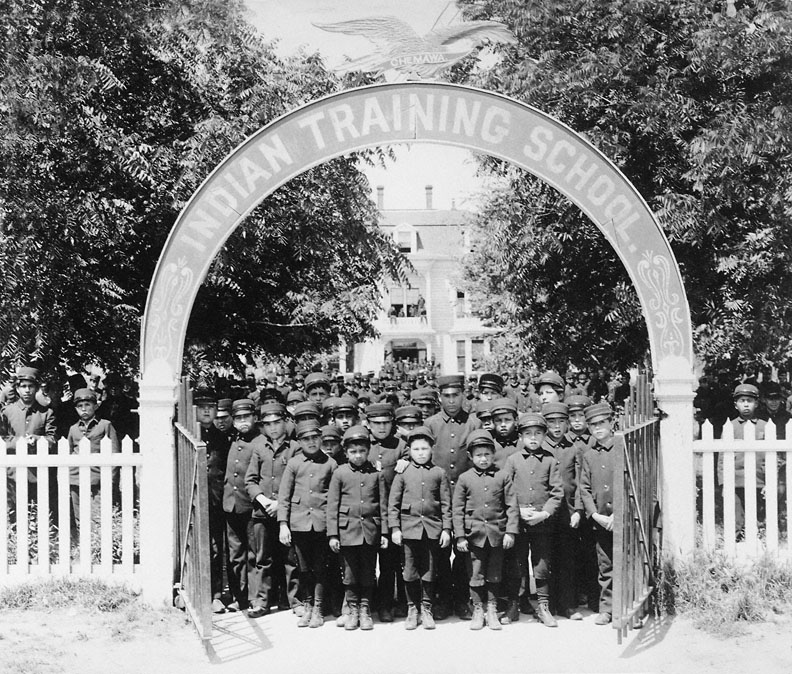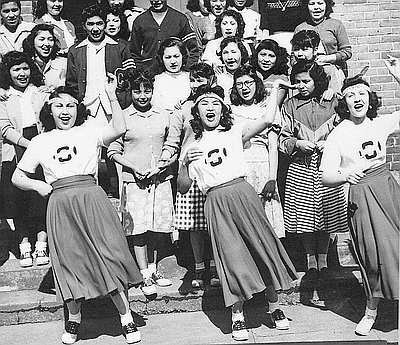- Catalog No. —
- OrHi 36112
- Date —
- c. 1900
- Era —
- 1881-1920 (Industrialization and Progressive Reform)
- Themes —
- Government, Law, and Politics, Native Americans, Oregon Trail and Resettlement
- Credits —
- Oregon Historical Society
- Regions —
- Willamette Basin
- Author —
- Southern Pacific Railroad Collection
Boys at the Chemawa Indian School
This undated photograph shows a school-wide view of the boys at Chemawa Indian School after it was moved to Salem in 1885. The promotional photo is part of the Southern Pacific Railroad Collection.
In 1880 the United States government authorized the construction of the Forest Grove Indian Training School in Forest Grove, Oregon. Due to local hostility, the poor agricultural potential of the school’s land, and the destruction of the girls dormitory by fire, the school was relocated in 1885 to the outskirts of Salem, Oregon and renamed Chemawa Indian Industrial School. Today, the school—renamed the Chemawa Indian School—is an accredited four year high school and is the oldest, continually operated Indian boarding school in the United States.
Throughout the first decades of its operations, the school was an institution designed for the assimilation of Indian peoples. By removing children from their families and communities—sometimes by force—and relocating them at the boarding school, administrators hoped to break down tribal identities and allegiances, replace Indian religious and cultural practices and beliefs with Christian teachings, and impose the use of English in lieu of Native languages.
Early administrators ran the school with a militaristic style of order and obedience. Boys had their hair cut short and were clothed in military-style dress. Chores, labor, and classes were initiated with bells. Many rules were even enforced by a hierarchy of ranks that mimicked military discipline.
The early educational curriculum of the school included reading, writing, arithmetic, and religious training. A heavy emphasis was also placed on vocational training. Boys were taught to farm and were required to grow food for the school. They were also relied on as laborers for school construction projects. Girls were taught the rudiments of housekeeping and sewing, helped maintain the school, and provided the student body with adequate clothing.
Further Reading:
Collins, Cary C. “A Future with a Past: Hazel Pete, Cultural Identity, and the Federal Indian Education System.” Pacific Northwest Quarterly 92, 2000: 15 – 28.
Collins, Cary C. “The Broken Crucible of Assimilation: Forest Grove Indian School and the Origins of Off-Reservation Boarding-School Education in the West.” Oregon Historical Quarterly 101, 2000: 466 – 507.
Reddick, SuAnn M. “The Evolution of Chemawa Indian School: From Red River to Salem, 1825–1885. Oregon Historical Quarterly 101,2000: 444 – 465.
Collins, Cary C. “Through the Lens of Assimilation: Edwin L. Chalcraft and Chemawa Indian School.” Oregon Historical Quarterly 98, 1998: 390 – 425.
Collins, Cary. “Oregon’s Carlisle: Teaching ‘America’ at Chemawa Indian School. Columbia 12, 1998 6 – 10.
Written by Joshua Binus, © Oregon Historical Society, 2003.

